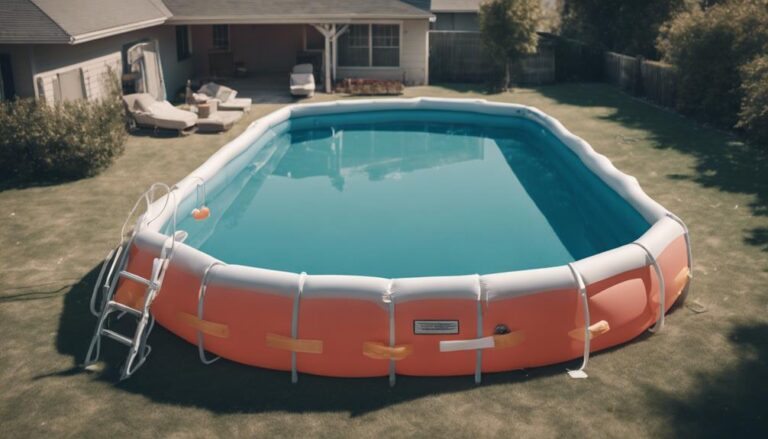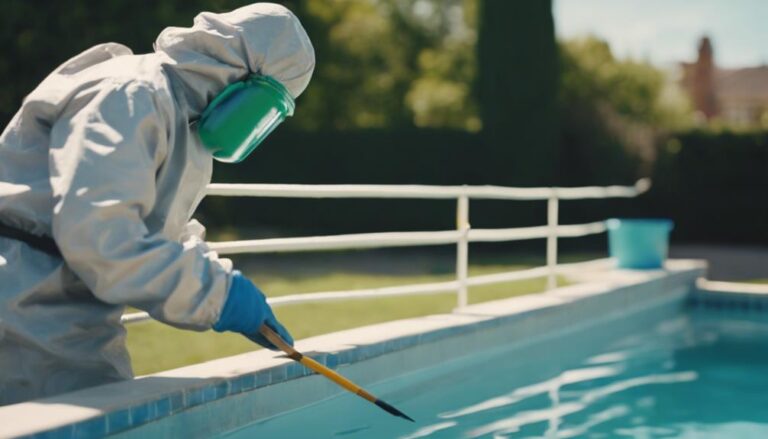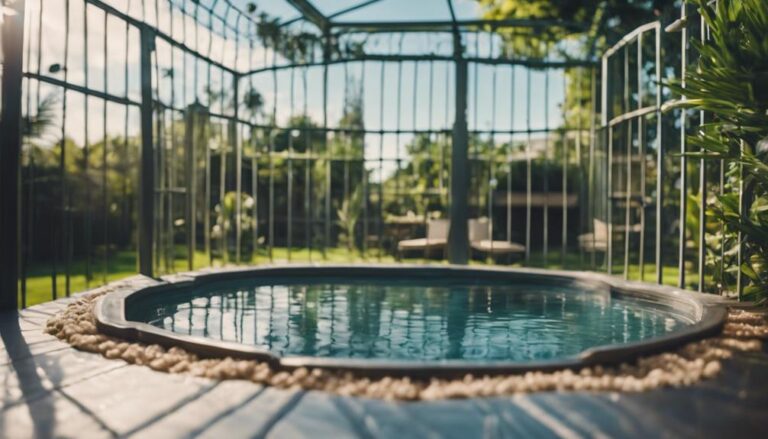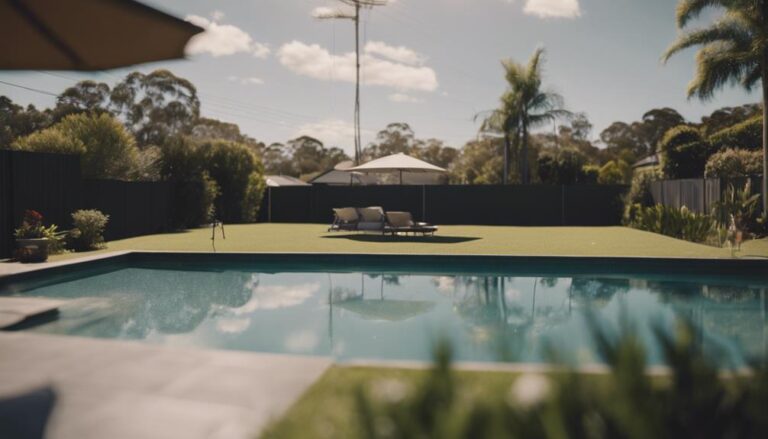Can I use a pool cover instead of a pool fence?
Replacing a pool fence with a cover does not offer the same level of safety and legal compliance. Pool covers are beneficial for keeping debris out and retaining heat, yet they do not provide a continuous barrier as fences do.
Pool fences serve as a primary defence, offering a secure, permanent boundary often mandated by law. These fences are equipped with self-closing gates, crucial for households with young children or pets.
Although covers are useful, they are not completely secure against unintended entry. Utilising both a fence and a cover ensures a pool area is both safe and enjoyable.
Learn how to maximise safety while complying with regulations in the enhancement of your pool area.
Understanding Pool Safety
Ensuring your swimming area is equipped with appropriate safety measures, such as a pool cover and fence, isn’t just a good idea—it’s essential for preventing accidents and complying with safety standards. Pool covers are helpful but have their challenges. Proper installation is crucial to avoid water collecting, which can present a hidden drowning risk, especially for children. There’s also the risk of children finding ways to get around a pool cover, leading to unauthorised access and increased danger.
To enhance the security of your swimming area effectively, combining a pool cover with a pool fence is a wise choice. A pool fence adds an extra level of safety, blocking direct entry to the swimming area and significantly reducing the chances of accidental drowning. Unlike pool covers, which can be difficult to secure properly, pool fences provide immediate and continuous protection. This dual approach ensures that your swimming area remains a safe, enjoyable space for everyone. Investing in both a pool cover and fence is not just about following the rules; it’s about ensuring peace of mind.
Benefits of Pool Covers
You’ll find that pool covers not only enhance your pool’s safety by preventing unwanted access, but they also reduce your cleaning time and expenses.
They’re easily obtainable at your preferred shops, ensuring you comply with safety regulations without spending a lot of money.
Improving Safety Measures
Investing in a pool cover not only maintains the cleanliness of your swimming area but also significantly increases safety by preventing unintentional falls into the water. Opting for a pool cover is a cost-effective and intelligent method for pool upkeep. Here are the reasons:
- Safety: Reduces the risk of unintentional falls, particularly for children and pets.
- Debris and Insects: Prevents the entry of unwanted guests, ensuring the cleanliness of your water.
- Warmth Retention: Special materials aid in retaining heat, making your pool comfortable for an extended period.
- Cost-effective and Accessible: Available at major retailers, ensuring affordability.
- Simple Installation: The process is straightforward, making it an uncomplicated safety measure.
With a pool cover, you aren’t only preserving water quality and simplifying pool maintenance but also making safety and regulatory compliance a priority with every splash.
Reducing Maintenance Costs
Beyond improving safety and cleanliness, pool covers are essential in significantly reducing maintenance costs. By preventing debris such as leaves, insects, and even frogs from entering the pool, a cover drastically reduces the time and effort needed for cleaning. This leads to savings on maintenance costs, making it a cost-effective choice.
Available in various colours, including options like black covers that help to heat your pool, these covers combine functionality with aesthetics seamlessly. Using a pool cover reduces the need for frequent cleaning and chemical treatments, further increasing your savings.
Given their affordability and availability, opting for a pool cover is a smart choice for any pool owner looking to cut maintenance expenses while keeping their pool in top condition.
Advantages of a Swimming Pool Fence
When you choose to install a pool fence, you’re not just enhancing the safety around your pool; you’re also ensuring compliance with many local regulations.
A fence provides a sturdy barrier that keeps children and pets away from the water when unsupervised, significantly reducing the risk of accidents.
Plus, with the added feature of self-closing and self-latching gates, you’re taking an extra step towards a secure pool environment. You can choose to build your own pool fence if you are wanting to save money.
Enhances Safety Significantly
A pool fence significantly improves safety by establishing a reliable barrier that deters unauthorised access, notably for children and animals. It’s crucial to have a barrier that’s sturdy and designed with the safety of your loved ones as a priority.
- Physical Barrier: A pool fence acts as a strong physical barrier that limits access, ensuring the pool area remains secure.
- Self-Closing Gate: Incorporating a self-closing gate guarantees the fence remains secured, even if inadvertently left open.
- Self-Latching Gate: A self-latching gate provides an additional safeguard against unsupervised access.
- Prevents Accidental Drowning: This measure greatly reduces the risk of accidental drowning, offering reassurance.
- Ideal for Pets and Children: It’s particularly recommended for homes with pets or children, ensuring their safety in the vicinity of the pool area.
Compliance With Legal Requirements
Ensuring your swimming pool area isn’t only safe but also adheres to legal standards, the installation of a pool fence is necessary to comply with various local regulations that aim to prevent unauthorised access.
Unlike a pool cover, a pool fence offers a permanent solution that meets legal requirements, greatly reducing the risk of accidents and incidents of drowning. By complying with specific safety standards and guidelines set by authorities, you’re protecting not only your loved ones—especially children and pets—but also adhering to legal obligations.
While a pool cover might provide temporary safety measures, it often doesn’t satisfy the stringent criteria required by law. Choosing to install a pool fence is the most effective method to ensure a secure, legally compliant pool area.
Regulatory Considerations
Given the range of regulations across Australia, it’s imperative to recognise that all swimming pools and spas with a depth greater than 30cm must have an approved safety barrier to meet legal requirements and maintain safety. The notion of substituting a pool cover for a pool fence should be dismissed due to the paramount importance of adherence to safety and compliance.
- Regulations are Explicit: Every pool, spa, and even paddling pools that exceed a 30cm water depth are obligated to comply with the Australian standards for safety barriers.
- Local Requirements Differ: Various states and councils may have distinct interpretations of these regulations. It’s advised to consult with your local council to ensure compliance with the law.
- Pool Fence is Compulsory: A robust pool fence isn’t merely a suggestion but a requirement to prevent accidents and guarantee pool safety.
- Compliance is Mandatory: Adhering to council regulations is critical for the safety of individuals.
- Safety Barrier Standards: Your safety precautions must conform to the Australian standards for pool fencing to be deemed compliant.
This guidance aims to provide a clear understanding of the necessity for appropriate safety measures for pools and spas, highlighting the legal and safety implications of non-compliance.
Safety Cover Limitations
While we’ve established the significance of pool fences for adhering to safety and legal standards, it’s vital to acknowledge that pool covers, despite their advantages, have certain limitations in preventing accidental drownings. It’s critical to recognise that pool covers may not consistently be effective in protecting against these tragic incidents. An improperly installed pool cover can result in water accumulating on top, which presents a considerable drowning hazard, particularly for children. This risk is magnified if children are able to remove the safety covers themselves, heightening the possibility of accidents.
Furthermore, pool covers that aren’t securely attached can become more of an encumbrance than an aid. They can be time-consuming and inconvenient to manage, detracting from the convenience and peace of mind they’re intended to provide. To ensure heightened safety around your swimming area, combining your pool cover with a pool fence is strongly recommended. This combination offers a robust defence against accidental drowning, ensuring that your pool is a source of joy and relaxation, not anxiety and risk. For optimal child safety and accident prevention, both secure installation and the diligent use of pool fences alongside pool covers are essential.
Installation and Maintenance
To ensure your swimming pool remains safe and adheres to regulations, it’s necessary to frequently install and remove your pool cover, securing it correctly at all times. This practice is vital not just for keeping the water clean but also to prevent risks such as water accumulation that could pose dangers.
Here is how you can keep your pool cover in optimal condition:
- Regular Inspection: It’s imperative to check for any tears or damage that could impair the cover’s functionality.
- Secure Anchors: The anchors must be securely drilled into concrete, which might necessitate the assistance of a professional.
- Prevent Water Accumulation: Employ a pump to eliminate any water that gathers on the cover, thereby averting potential hazards.
- Routine Cleaning: Regularly wash the cover to prevent the build-up of algae and debris.
- Professional Installation: Engaging professionals for the initial installation is advisable to guarantee accuracy.
Making the Right Choice
When choosing between a pool cover and a pool fence, it is crucial to prioritise safety and compliance with regulations to create a secure and lawful swimming area. While pool covers are useful for keeping debris out, they do not provide the same level of security and restricted access as pool fences. Even though a securely fastened pool cover may seem adequate, it does not have the ability to prevent accidents or drownings as effectively as a pool fence with self-closing and self-latching gates.
Pool fences offer unparalleled protection against unauthorised access, significantly reducing the risk of accidental drownings. This is especially important in households with children, who may find the allure of the pool irresistible. Using both a pool fence and a pool cover ensures maximum safety, keeping your pool clean and secure.
Choosing both a pool cover for cleanliness and a pool fence for security is the recommended approach for pool owners. Following this comprehensive strategy guarantees the safety of your family and compliance with safety regulations, providing peace of mind and a secure, enjoyable swimming environment for everyone.
Frequently Asked Questions
Is it illegal to not have a fence around a pool in Australia?
Yes, it is illegal not to have a fence around your pool in Australia. All pools and spas deeper than 30cm must have a compliant safety barrier to prevent accidents and comply with regulations. Stay safe!
Can you walk on a pool cover?
You shouldn’t walk on a pool cover, as it’s not designed to bear your weight. Doing so can damage it and compromise safety. Always keep off to ensure it performs its heat-retaining and debris-blocking roles effectively.
Do you always need a fence around a pool?
Yes, you often need a fence around your pool for safety and compliance with local laws. It’s crucial to check your area’s regulations to ensure you’re meeting the required standards for pool safety.
What is the fine for not having a pool fence in Victoria?
You will face a fine between £1,652 and £8,261 in Victoria for not having a pool fence. It is essential to comply with fencing regulations to avoid substantial penalties and to ensure everyone’s safety around your pool.






